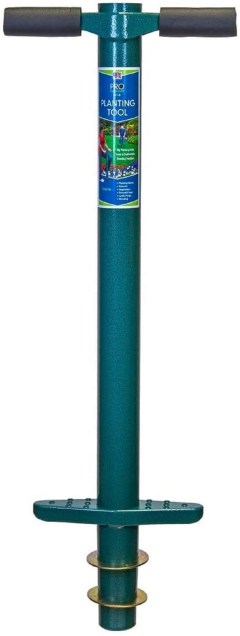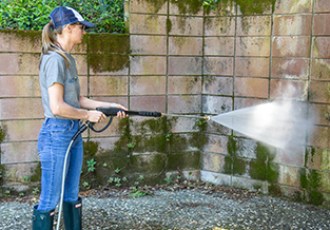BestReviews is reader-supported and may earn an affiliate commission. Details

Consider this multipurpose gardening tool that also works as a weeder, sod plugger, and more.
Consider this multipurpose gardening tool that also works as a weeder, sod plugger, and more.
Can also be used as a lawn and sod plugger, soil sample tool, and drip-edge fertilizing tool. Features a depth ring that enables you to dig holes up to 6 inches deep from a comfortable standing position.
Soil may get stuck inside plug. May need tool to unclog it.

Best option for those with hard clay soil.
Best option for those with hard clay soil.
Made with solid oak and stainless steel. Simply push into soil and drop in bulb. Leather loop makes this easy to hang. T handle for easy use and consistent hole depths.
Some owners say the handle eventually breaks off but can be easily repaired.

The long handle makes this a top choice for gardeners who often get riddled with back pain.
The long handle makes this a top choice for gardeners who often get riddled with back pain.
Durable construction. A long handle prevents excessive bending. Simply insert into ground, step on edge and twist. Pull up, then drop in seeds. Earns bonus points for cushioned handle.
For optimal usage, you should moisten soil first.

This tool will let you get the job done in the most time and energy-efficient way.
This tool will let you get the job done in the most time and energy-efficient way.
Simple process. Attach product to a drill, turn on, and pull out when auger has gone as deep as possible. Effective against any kind of soil. Easily reaches 6-10 inches into soil, but some owners have gone as deep as 18 inches.
More difficult to use in hard, clay-like soil.

Best non-electric way to plant tulips, daffodils, lilies, and dahlias.
Best non-electric way to plant tulips, daffodils, lilies, and dahlias.
Faster and easier than using a trowel. Simply insert into dirt, twist and remove. Product holds dirt while you plant, and then releases dirt to cover the hole. Many owners say that the metal has never bent.
Will need to exert more energy when using on rocky soil.

We recommend these products based on an intensive research process that's designed to cut through the noise and find the top products in this space. Guided by experts, we spend hours looking into the factors that matter, to bring you these selections.

A well-landscaped house not only helps to beautify the neighborhood as a whole, but it also gives the homeowner a sense of pride. The greatest obstacle to a beautifully decorated lawn is the work that’s required to landscape it. Rather than get new seeds and flowers to plant every spring, consider planting perennial bulbs that will bloom year after year. For that, you need a bulb planter.
Planting individual seeds or flowers can be backbreaking work, but planting bulbs doesn’t need to be. You can choose from bulb planters with different handle styles and lengths, manual or powered versions, and planters with extra features to help ease your workload.

Soil release: This type of bulb planter has handles with grooves for your fingers. The planter grabs the soil that needs to be displaced in order to plant the bulb. Once the bulb is in the hole, you release the soil to cover the bulb. While this type of bulb planter is small and easy to store, it also requires you to kneel in the soil or bend over to operate it. That can be a negative feature for those who have back problems or who have trouble standing up from a kneeling position.
Dibber: A dibber is a pointed device that’s used to make holes in the ground so seeds or bulbs can be more easily planted. A dibber is also a handheld bulb planter, but it works differently than one that grabs the dirt. You simply twist the dibber in the dirt to make a hole deep enough to press the bulb into; you then manually cover the bulb with the displaced dirt.
Spade/knife: This type of bulb planter is similar to a handheld garden trowel, but the spade portion is slightly narrower. The handle has a cushioned grip for comfort. You simply dig into the dirt, making twisting motions to create a hole deep enough for the bulb. The spade is curved and can be used as a small trowel to remove excess dirt from the hole.
Bulb planters with longer handles can be easier to manipulate and require less bending than handheld versions. They usually have a T-shaped handle at the top with a spade or soil plunger at the bottom. You simply place the bulb planter on top of the soil where you’d like to plant your bulb and press down on the handle to push the planter to the required depth. Pull it back out of the soil before inserting your bulb. Those bulb planters with plungers hold the displaced soil, while those with spades may “pop out” the core of the hole for you to replace manually.
Manual bulb planters are for those who can handle a bit more effort. They require some strength to push the planter into the soil and lift the soil out of the hole.
A powered bulb planter (bulb auger) is usually attached to a drill, and the drill does the difficult work for you. The drill spins the auger to dig a deep enough hole for the bulb. These look like mini ice-fishing augers.
Some bulb planters include a ruler on the spade portion (or the portion that goes into the ground), so you know how deep the hole is. The measurements are usually in increments of an inch.
Some long-handled bulb planters have a footrest to step on so you can use all your body weight to dig the hole. This type of bulb planter requires less arm strength, and some believe it’s easier to use than a handheld version.
A quick-release feature is found on bulb planters that grab or hold the displaced dirt while you plant the bulb. A lever or button releases the dirt back into the hole you just put the bulb into. It reduces the time it takes to plant each bulb, which is useful if you’re planting many bulbs.
Some bulb planters are marketed as multi-tools because they can be used for several purposes in the yard and garden. For instance, a long-handled multi-tool may plant bulbs, sample soil, and help pull weeds.
Inexpensive: The most affordable bulb planters are manual handheld versions that cost between $5 and $10. These planters work efficiently for one season, but if you plan to use one every year you might need to upgrade at some point.
Mid-range: You can find handheld or long-handled bulb planters for $11 to $20. These planters are made of slightly better materials, but it’s possible they will only last for a season or two. Many have basic features like a quick-release function and a footrest.
Expensive: Spend more than $20 and you can find long-handled planters that will last for several seasons. These have all the features required for efficient planting. They’re made from durable materials, and some are multi-tools.

Q. What happens if I plant a bulb too deep?
A. If you plant a bulb too deep, it’s possible it will suffocate in the dirt and rot. The bulb may still grow, but the plant will look compromised. A way to identify bulbs that were planted too deep is to look for those that don’t produce any blooms.
Q. Can I just throw the bulb in the hole, or does it need to be placed a specific way?
A. It absolutely should be placed a specific way. Place the bulb in the hole with the roots down and the pointed end up.
Q. The measuring guide has worn off my bulb planter, what should I do?
A. If you can’t afford a replacement, use some duct tape or masking tape on the tool as a measurement marker. Measure the correct depth with a ruler or tape measure, and place the tape on that spot as a guide.
Get emails you’ll love.
Learn about the products you’re wondering if you should buy and get advice on using your latest purchases.
